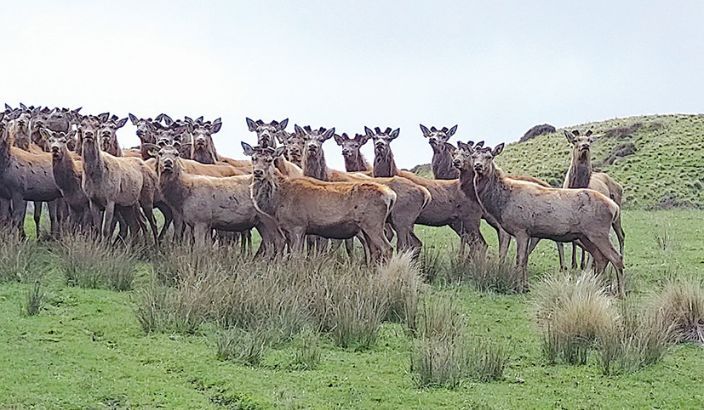Velvet values down, but resilience remains

Can you spot the difference? The central stag still has his buttons, while the one on the left and four others in the background are already growing velvet-covered antlers—a fascinating glimpse into the stages of antler development. Photo: Supplied.
As velvet season nears its close, Seddon-based deer farmer and former New Zealand Deer Farmers Association (NZDFA) chair, Justin Stevens, reflects on an industry in transition.
With velvet prices down around 20 percent from last season, questions around sustainability, pricing, and profitability are at the forefront of many minds across the sector.
“Velvet pricing is down around 20 percent from last season – that’s just the market and what the price buyers are willing to pay,” says Justin.
“Are we producing too much? Potentially, we could be by around five percent every year. If we were down on supply, then demand could see the price lift.”
Top of the South’s velvet season typically runs from mid-October to the end of January, and Justin’s operation produces around 1,800 kilos of velvet per season—part of a national output of around 1,100 tons.
While demand remains strong in Asian markets, primarily used as a component in natural health products, global economic shifts and frozen velvet export disruptions to China created uncertainty this season.
“Frozen velvet exports to China operated in a grey area for nearly six years until shipments stopped in April 2024, bringing some long-needed clarity. While trade resumed in November 2024, the disruption created lingering uncertainty.”
Justin says that during this time, some buyers pushed prices down, weakening and destabilising the market – the impact is still felt by farmers and the wider industry.
Rising input costs continue to put pressure on velvet and venison prices.
“Farm input costs have risen by 55 percent over the past four years. So, if I spent $10,000 on something in June 2020, by the end of June 2024, that same expense would cost me $15,500,” Justin explains.
“Like other farmers, we have looked for opportunities to cut back and make our business more viable, but you can only cut back so many times and for so long; it is very challenging.”
Justin also points out that while lamb prices delivered strong returns this season, velvet still outperformed lambs by around 10 percent per stock unit. He adds that a change in the lamb schedule in the coming year could bring the two more in line. He also notes that diversity for venison farmers could help them turn a profit.
“Elk meat is going well and making more than venison, there is a demand there, too. Can farmers adapt and make a bit more a kilo while meeting the markets need?”
Justin is not alone in exploring ways to make some small gains in tough times. The past few years of drought impacted feed supply and profitability. As well as shipping costs, compliance, and logistics all biting into margins.
“Everyone past the farm gate needs to look at their operation. If we can’t provide better returns to farmers, what are we doing?” Justin asks.
Despite market pressures, Justin remains cautiously optimistic. He sees opportunity in smarter marketing and product diversification—such as promoting venison silverside, bacon, and other cuts often undervalued.
“Venison is known for its high iron and protein; we need to work on using lower-value cuts better – optimise, not discard.”
He adds that everyone needs to work together as “when farmers aren’t making money, the processors, stock agents and alike aren’t either.”
Statistics highlight these challenges, with rising stag and deer numbers suggesting that oversupply—rather than strong demand—is influencing prices.
In 2023, 34,000 mature stags were processed, nearly triple the number from 2018 where there was 12,000. Overall, deer numbers also climbed, with 249,000 animals processed in 2023 compared to 200,000 in 2018, a rise that initially followed a venison price drop.
Justin sums up the season by saying: “The velvet season started off at levels lower than last year, which is disappointing when we consider that sales of heath food supplements in Korea had increased by 22% over the previous year. Eight out of 12 new deer velvet health food products that were launched in Korea in 2022 contained. and were marketed as, containing New Zealand Deer Velvet.”

He explains: “Venison prices have been making their way upwards over the past season and peaked at just over the $10/kg level, which makes a big difference to all our deer farmers.
“On our farm, venison still makes up around a third of our total deer income and is a very important part of our farm income. Economic growth in China was sitting at around 5%, and with China now an important market for both velvet and venison, it was hard to see why the price for velvet dropped from the previous season.”
However, while the outlook ahead is mixed, Justin believes that with smart adaptation, the sector will ride out the challenges.
“When times are tough, you get tougher. Keep those 10 animals—it might cost now, but you could gain later. There’s always a way through.”
